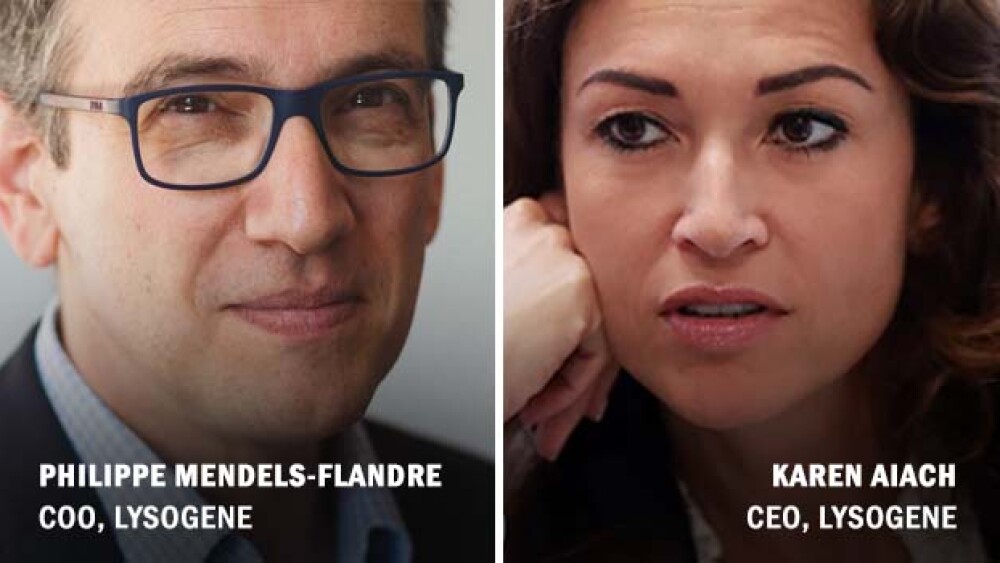Finding a treatment for Sanfilippo Syndrome is a personal matter for the Lysogene team.
PARIS – Finding a treatment for Sanfilippo Syndrome is a personal matter for the Lysogene team.
Lysogene was founded by Karen Aiach in 2009. Her daughter was diagnosed with Sanfilippo Syndrome A (also known as Mucopolysaccharidosis Type IIIA), a rare inherited metabolic disorder where the body cannot break down long chains of sugar molecules known as glycosaminoglycans. Of the four types of Sanfilippo Syndrome, Type A is the most severe and most common. The life expectancy of children with Sanfilippo Syndrome is 10 to 20 years.
When confronted with the diagnosis, Aiach became proactive. Although she had little scientific background, Aiach sought out experts in the field and pushed for the development of a treatment.
“She was told there was no cure (for Sanfilippo) so she decided to begin research and trying to understand what could be done with the disease,” Lysogene Chief Operating Officer Philippe Mendels-Flandre said in an exclusive interview with BioSpace.
Through her research, she met with Olivier Danos, a gene therapy specialist who currently serves as chief scientific officer of REGENXBIO. Danos, now a scientific advisor to Lysogene, and Aiach teamed up to form Lysogene. The new company focused on using adeno-associated viral (AAV) vectors to target the disease. Now the company plans to move its lead Sanfilippo Syndrome product into a Phase II/III trial next year.
“She is so passionate about bringing hope to people who have these diseases,” Mendels-Flandre said.
Lysogene has already conducted a Phase I/II clinical trial, as well as a natural history study, focused on the development of LYS-SAF301, a rAAV vector serotype rh.10 carrying the gene coding for SGSH. The gene therapy program is delivered directly to the central nervous system in one neurosurgical procedure. After initial data that showed Lysogene’s Lys-SAF301 demonstrated some efficacy, but not enough to be a disease modifier, the company went back to work and tinkered with the product. Now Mendels-Flandre said the company is months away from beginning a Phase II/II study in Sanfilippo. They have plans to enter the clinic in the first half of 2018.
LYS-SAF301 will be administered directly into the brain of patients during the trial through micro-bore holes. Mendels-Flandre said that is the most effective way of getting past the blood-brain barrier. He said the procedure can sound scary but is a rather straight-forward process with a fairly high safety profile. Lysogene hopes to administer the product to about 20 patients in the Phase II/III trial.
Lysogene is planning to file its Investigational New Drug Application in the second quarter and hopes to begin dosing its first patients by June 2018.
In addition to the Sanfilippo Syndrome treatment, Lysogene is also developing a second therapeutic for GM1 gangliosidosis. LYS-GM101 is Lysogene’s AAVrh10-based gene therapy. In May, Lysogene and Brammer Bio entered a strategic manufacturing agreement to produce LYS-GM10 for its clinical studies. Preclinical data of GM1 show that LYS-GM101 treatment delivers a functional gene encoding the ßgal enzyme, resulting in a reduction of GM1 gangliosides and transforms the animal phenotype. Lysogene hopes to enter the clinic for this therapy in early 2019.
“We have a very busy agenda,” Mendels-Flandre said.
Lysogene business has not been isolated to the laboratory. The company recently established a footprint in the United States. France-based Lysogene has opened offices in Cambridge, Mass. in order to take advantage of a deep pool of talent that can advance the company’s gene therapy treatment.
“We want Lysogene to be an international company. To be on both sides of the Atlantic makes sense,” Mendels-Flandre said.
Currently, Lysogene has five employees based in the Cambridge offices and 12 in France. Establishing a footprint in the United States was important for the company’s long-term goals of securing regulatory approval for its developmental products.
As its first hire, the company tapped Sean O’Bryan as its vice president of Regulatory Affairs and Quality Assurance. In fact, three of the company’s U.S.-based employees are part of the executive team. In addition to O’Bryan, Cambridge is home to Chief Technical Officer Mark Plavsic and Kimberly Gannon, the company’s chief scientific officer.
Mendels-Flandre said Lysogene could hire some more employees for its U.S. site, but did not specify when or how many. He said the company was likely to remain lean as it continues to move forward with its clinical programs.
Since the company’s launch in 2009, Lysogene has raised more than $45 million in financing. That includes an initial financing round of $19 million and another $29 million in an initial public offering. Mendels-Flandre said the company is sufficiently funded through the end of next year. Although, he added that until the company gets its products approved for commercialization, Lysogene will have to continue to seek financing to support its research and operations.





